Volume a new height: Weibu Space Telescope discovered the recorded ancient galaxy
Author:Institute of Physics of the Ch Time:2022.08.01
Recently, astronomers announced that they had discovered an galaxy with a red movement of 13, which was about 330 million years at that time. Earlier, the recorded is the galaxy with a red transfer of 11, which is about 420 million years in the universe. Webb has promoted the most popular galaxy that humans saw to the birth of the universe for about 100 million years. This is just a relaxed start of Weibu. What we can expect is that the opening of Webb will get a greater breakthrough in the future in the future, leading humans to crack the mystery of the extremely early universe.
Written article | Wang Shanqin
On July 12, 2022, the first batch of images obtained by the James Webb Space Telescope (JWST or "Webu") were officially announced in the highly anticipated grand occasion. This group of photos not only shocked professionals in the astronomical circle, but also shocked many people eating melon outside the circle.
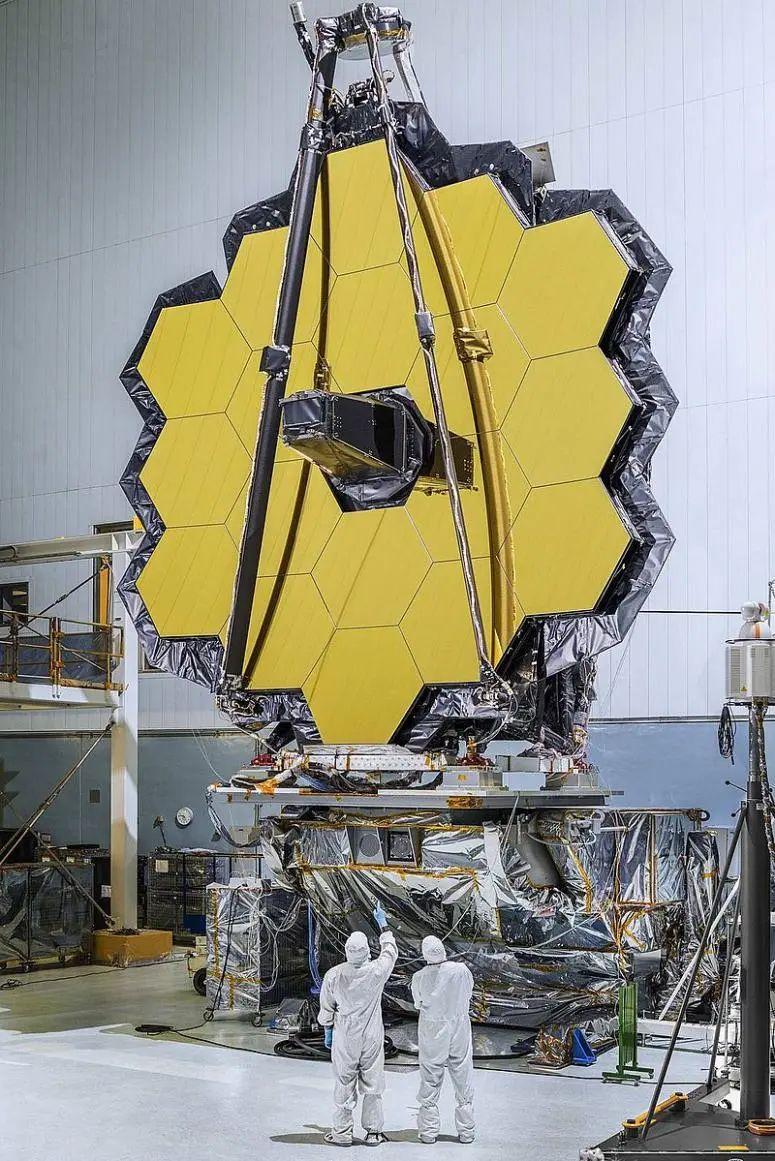
Figure: In 2016, the main mirror of Weibu and the folded auxiliary mirror and bracket. Source: NASA
However, a melon did not fall, and a melon rose again: On July 20, a cooperative team led by astronomers at Harvard University announced that they found a recorded galaxy in the image taken by Weibu: it was in the Big Bang of the Universe After about 330 million years, it has been formed, and it is the oldest galaxy that has been discovered so far.
How to determine the red shift of the celestial body?
Red shift is one of the most critical basis for measuring the distance and age of celestial bodies. Due to the inflation of the celestial body or the expansion of the universe itself, the light waves from the celestial body will change. If the light wave becomes longer, it is red shift; if the light wave becomes shorter, it is a negative red shift, that is, blue shift.
This name is limited by the times: the wavelength that astronomers who can observe more than 100 years ago were basically limited to visible light, and the wavelength of the red light in the light was the longest and the wavelength of blue -purple light was the shortest. Therefore, the visible light of other colors move towards the red end, which is red. With the expansion of the wavelength range of observation, astronomers have already observed the phenomenon of red light moving towards infrared. However, according to the convention, such movement is still called "red movement", not "infrared movement". We only need to remember: "red shift" refers to the longer wavelength.
The light emitted by the celestial body contains the radiation emitted by the atoms of many elements. These radiation is caused by the transition of electrons in the atom, and they all have a fixed wavelength. In the process of parting of the celestial bodies to the earth, after the radiation of some bands was absorbed by its own atmosphere or interstellar media, the intensity became weakened and displayed as the absorption line.
In the spectrum of measured celestial bodies, if the wavelength of a certain element's absorption line is different from the wavelength measured in the laboratory, it shows that it produces red or blue. Reduce the two and then remove the wavelength measured by the laboratory, which is the value of red or blue.
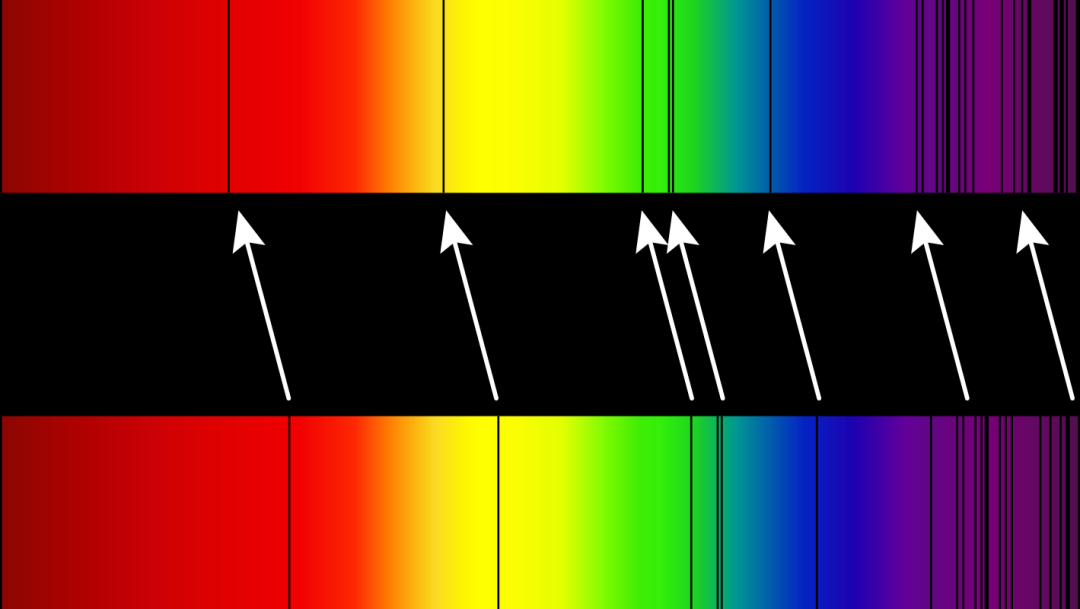
Figure: The schematic diagram of the red shift (dark line in the figure) occurs. The arrow indicates the movement of the spectrum.丨 source: Georg wioora
For example, the e -electrons of hydrogen atom transitioned from the 2nd, 3rd, 4th, 5th, 6th orbit to the first orbit (base state). It is the first few of the famous "Lyman line". These cables are also known as the Lehman alpha line, the Lyman β line, the Lehman γ line, and so on. If we observe the wavelength of the Lyman alpha line of a certain celestial body, it becomes 1215.7 nanometer, then we can subtract 1215.7 to subtract the wavelength measured in its laboratory 121.57, and then except 121.57. Essence
When some distant galaxies are radiated through many interstate molecular molecular clouds that are rich in hydrogen -rich galaxies, the Lyman alpha line (and other Lyman lines) contains will be severely absorbed by the hydrogen in the molecular cloud, causing its brightness to appear cliff -like -like format The decline in the wavelength is much lower than the brightness of the radiation shorter than the Lyman alpha line than other wavelengths. Such galaxies are called "Lyman-Break Galaxies (LBG).
After observing the Lyman fracture galaxy, the wavelength of the break is measured, and then compared with the wavelength (121.57 nanometer) in the laboratory, it can calculate its red shift. In fact, of course, the operation should be more complicated: through the model fit, to obtain its theoretical can spectron, thereby determining the specific wavelength of Lyman's break, and then calculating its red shift.
Once the champion: GN-Z11
Earlier, the oldest galaxy found in the image taken by astronomers in Hubble is GN-Z11. The G in this number represents the "The Great Observatories Origins Deep Survey (GOODS), which is the Hubble Space Telescope (hereinafter referred to as" Hubble ") and some space X -ray telescopes and ground telescope mirrors. Jointly perform multi -band observations. Goods observations are represented by S and N, respectively. So GN represents Beitian District observed by this project.
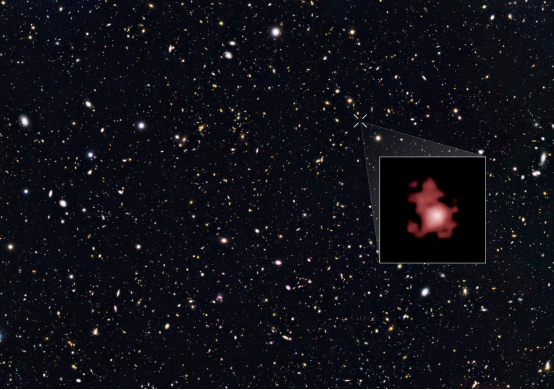
Figure: The magnifying graph (small picture) of the GNZ-11 observed in the northern region of Goods. This is a picture of visible light and near -infrared data obtained by Hubble's ACS and WFC3. Source: NASA, ESA, and P. OESCH (Yale University)
In 2016, the team led by the astronomer Pascal Oesch at Yale University combined with the image of the observation of Hubble and the Spezer Space Telescope to obtain the Huber's third -generation wide field camera (WFC3) edge grid spectrometer in the GN observation area The spectrum of this galaxy. They found that the ratio of the radiation flow on both sides of this galaxy spectrum was less than 0.32. [1] Therefore, it is a Lyman fracture galaxy. OESCH et al. Use the Lyman fracture galaxy template to fit its energy spectrum (see the figure below) to determine that the wavelength at the "Lyman Fracture" is about 1.47 microns (1470 nanometer), and its red shift is about 11.09. Because its red shifts to 11, there is "Z11" in the number.
Figure: The energy spectrum of GNZ-11 indicates that its red shift is about 11.09. The dark red line is the theoretical scores that use the "Lyman Frail Galaxy" (LBG) template. The down arrow represents the upper limit of observation. The fitting quality of the other two models is much lower, which excludes the possibility of this galaxy as a low -red shift galaxy.丨 source: reference [1]
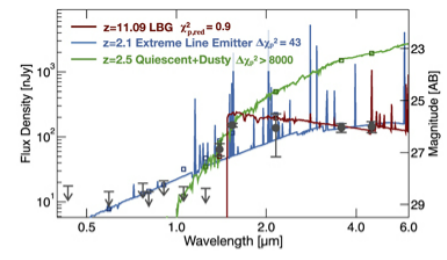
Calculating the age of the galaxy based on the red movement depends on some cosmic parameters. Suppose the current Hubble constant is 69.6, the proportion of material in the universe is 0.286, and the proportion of dark energy is 0.714. /Cosmocalc.html).
In such a universe, the universe where the galaxy is located 11 is 419 million years, and its "life span" is at least 13.302 billion years.
The holder of the new record: GLASS-Z13
The GN-Z11's champion throne has not yet sat for a few years, and it was replaced by the farther galaxy discovered by Weibu. This time the record galaxy was named Glass-Z13.
Figure: pseudo-color image of Glass-Z13. Source: Naidu et al, P. OESCH, T. Treu, GLASS-JWST, NASA/CSA/ESA/STSCI
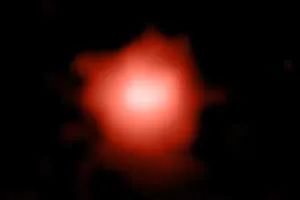
Glass-Z13 Glass is an English abbreviation of "GRISM Lens Amplified Survey from Space". The GLASS project observes 10 galaxies and 10 air areas near them. One of the galaxies is Abell 2744. It is also the famous "Hubble Frontier FRELDS (HFF). one.
Figure: The sky (left) of the ABELL 2744 obtained by the Hubble Writing project and the "parallel area" near the world. Source: NASA, ESA, and J. LOTZ, M. Mountain, A. KOEKEMOER, and the hff team (left); reference [2] (right) (right)
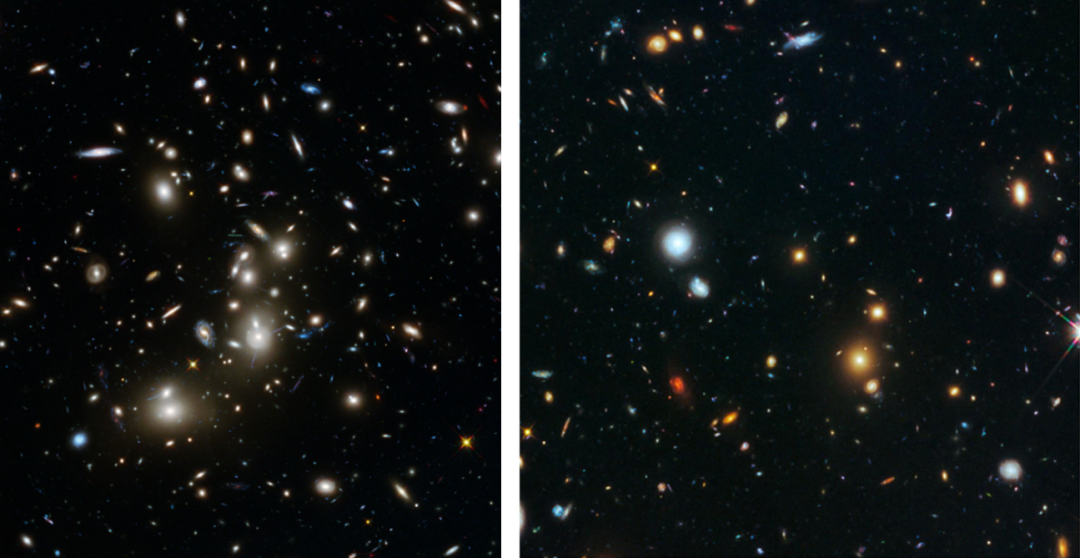
Webu uses the image of ABell 2744 in the sky and the nearby heavenly districts with nearly infrared cameras, and uses nearly infrared imaging instruments and Near-Infrared Image and Slitless Spertrograph (Niriss) and near infrared spectrometers (Near-Infrared Spectrograph (NIRSPEC) obtained the spectrum of celestial bodies. These data obtained by Wabbu were released as one of Early Release Science (Early Release Science (ER). This project is therefore called "Glass-JWST-ERS".
A team led by the Rohan Naidu's Rohan Naidu at the Harvard University-Smith Astronomy (CFA) confirmed the Glass-Z13 [Note 1] in the data obtained by Glass-JWST-EST. It must be mentioned that the Pascal Oesch of the GN-Z11 was also a member of the team [Note 2], ranking second in this team.
The 7 small maps at the top of the figure below are the observations of the 7 bands of GLASS-Z13 on Nircam. The central wavelengths of these 7 bands are 0.9 microns, 1.15 microns, 1.5 microns, 2.0 microns, 2.27 microns, 3.56 microns and 4.44 microns. In these bands, Nircam's observation time for GLASS-Z13 is 3.3, 3.3, 1.7, 1.5, 1.5, 1.7 and 6.6 hours. [3]
Figure: The image (top) of Glass-Z13 shot by the 7 filters of Nircam of Wokbudi, and the density of the flow of the bands (bottom left, the stars of different bands in different bands, etc.) Get the red shift (bottom right). The down arrow represents the upper limit of observation. The orange -red line is the theoretical scores that use the "Lyman Frail Galaxy" (LBG) template.丨 source: reference [3]

From the observation images of the 7 bands in the figure above, we can intuitively see that no Glass-Z13 images in the three wavelengths with short wavelengths, so only the upper limit of brightness can be given. Obvious galaxy images appear in the 4 wavelengths of the wavelength, so the accurate brightness value can be obtained. Draw the brightness or upper limit of the 7 band into the diagram of the energy spectrum, you can judge the general position of the wavelength of the Glass-Z13 "Lyman Fracture", which will be between 1.5 and 2.0 microns. NAIDU et al. Use the "LBG" ("LBG" in the figure) template to fit the theoretical spectrum (orange line in the figure above) to determine the specific value of the wavelength of the "Lyman Fracture" of the galaxy.
According to the fitting diagram, we can see that at the slightly greater than 1.6 microns (1600 nanometer), the flow of Glass-Z13 fell a cliff-like decline, so this wavelength is the position of the Lyman alpha line of this galaxy. If we roughly minus 1.6 microns (1600 nanometers) off the wavelength (121.57 nanometer) in the laboratory, and then the latter, we can get about 12 red shifts. In fact, because of its fracture wave length slightly greater than 1.6 microns, the red movement that was finally obtained was 12.4 or 13.1 (different models were used, and the values obtained were slightly different).
According to the cosmic parameters taken above, the cosmic Glass-Z13 of the red movement of 13 is 332 million years, and its "life span" is at least 13.388 billion years. In the year, it is close to 100 million years. Therefore, we can say that Webb has easily pushed the farthest galaxy that humans saw to the universe for about 100 million years. [Note 3]
According to the model fit, the quality of the Glass-Z13 is very low, only about 1 billion times the quality of the solar. [3] As a comparison, the quality of our galaxy is about 1 trillion times the quality of the solar. Therefore, the quality of Glass-Z13 is only about one-thousandth of the Galaxy quality.
The model also shows that Glass-Z13 has been in the universe at the time of about 71 million years (the upper and lower errors are 32 million years and 33 million years, respectively). [3] The age of the universe itself was only about 332 million years, so it was born about 260 million years after the birth of the universe.
The near-infrared radiation of the Glass-Z13 (and other high-red-transpaling galaxies with a red shift of about 10) by Webb detected was originally UV radiation emitted by these galaxies. Due to the expansion of the universe, these ultraviolet rays were stretched to the infrared when the ultraviolet rays reached the earth.
Taking the radiation of 4.44 microns as an example, except for (13+1), it is 0.317 microns, that is, 317 nanometers, which belongs to nearly ultraviolet rays. The shorter wavelength near infrared, except for the same value, obtained a shorter wavelength of ultraviolet rays. Therefore, only those galaxies with bright ultraviolet radiation can be detected by Wabbu.
As for the visible light radiation emitted by the ancient galaxies, after such a big red shift, it was already infrared radiation when it reached the earth. Web's medium -infrared equipment (Miri) was a powerful tool for detecting these medium infrared radiation.
Roll out a new height
Naidu et al. The paper was uploaded to the pre -printing website Arxiv on July 19, 2022, and was published by the system on the 20th. Similar papers that were also uploaded to ARXIV on July 19 and published on the 20th were a papers published by a team led by Marco Castellano, the Institute of Celestial Physics, Italy. [4]
The papers of Castellano et al. Also use the data released by Glass-JWST-EES, which confirms some galaxies between 9 and 15. Among them, the red shift of the two galaxies with more than 10 red shifts is GHz1 and the GHz1 and the names of GHZ1 and the names GHZ2, their red movement is 10.6 and 12.35, respectively.
Castellano and others also use the "Lyman Fracture" method to determine the wavelength of the break, thereby determining their red shifts. Among the 7 filters used by Webb's NIRCAM, the two short wavelengths of the short wavelength have not been detected by the galaxy, and the other five long wavelength images detect the galaxy. Castellano et al. Based on the Template of the Lyman Fravian galaxy, the red shift of these galaxies was combined, as shown in the figure below.
Figure: GHz1 (left) and GHz2 (right) of the 7 filter of Woku's Nircam and GHZ2 (top) and the stars obtained according to the data obtained by the data obtained Establishing energy spectrum). The small figure in the figure below is the red shift obtained. The down arrow represents the upper limit of observation. The picture shows the obvious Lyman breakage characteristics.丨 source: reference [4]
GHZ2's red movement is less than Glass-Z13, so it does not cause media sensation. It can be seen that this area has been rolled to a fairly amazing level.
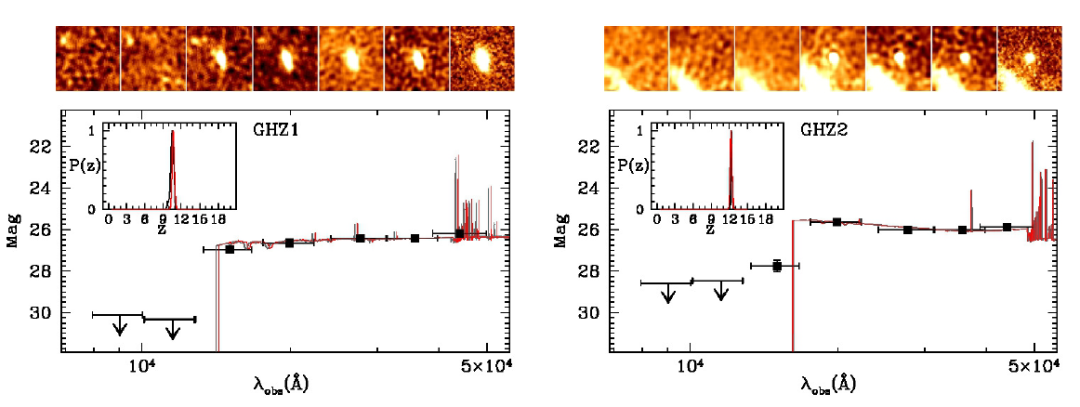
What we can foresee is that after that, according to the data obtained by Webu, the competition of higher red -shift galaxies will continue to be fierce and more internalized, and new distances will continue to refresh the old record. This competition and internal rolls are very useful for human understanding of the border of the universe. We expect Webb to have a greater breakthrough in this regard in the future, and even discover the first generation of galaxies and the first generation of stars.
Figure: The depth of the universe that can be detected by different times and different telescopes. Below pink marked is redshift. The white character is marked with the age of the universe corresponding to the red shift, which is 1 billion years. Weibu's observation goal is galaxies and stars with red movement to 20 and the age of only 200 million years in the universe. Source: NASA, ESA
Annotation
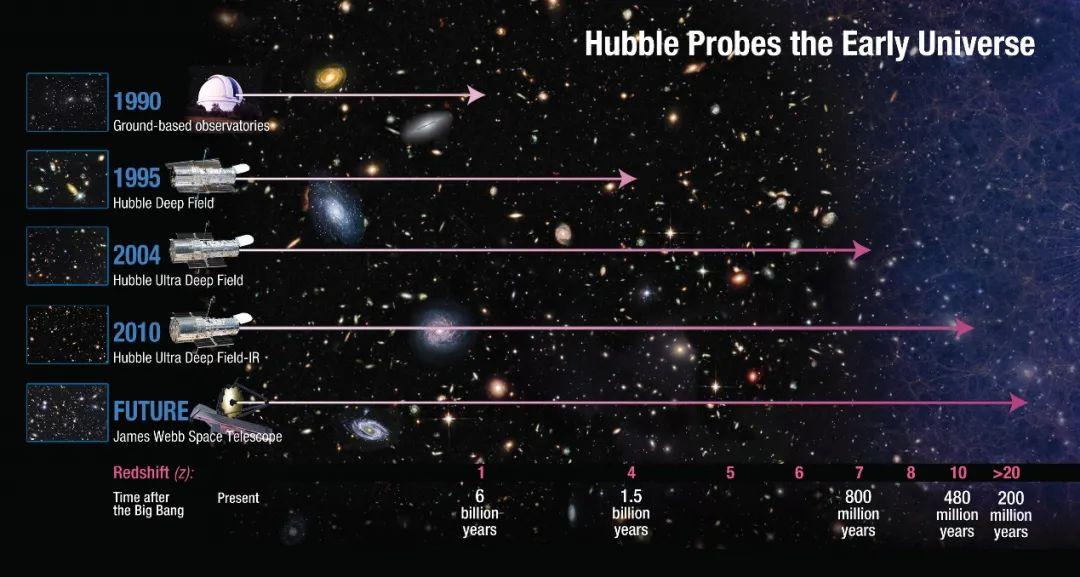
[Note 1] Because Glass-Z13 is located in the sky area where Abell 2744 is located, it is not in the first full color map (SMACS 0723) released by Webu.
[Note 2] Pascal Oesch is currently the Department of Astronomy of the University of Geneva, Switzerland and the Bohl Institute of Hargo, the University of Denmark.
[Note 3] Although different cosmic parameters will lead to different specific values of age and age (13.7 billion to 14 billion years), the age differences of ancient galaxies at different red shifts have only very slight changes.
references
[1] OESCH, P. A., et al. A Remarkably Luminous Galaxy at Z = 11.1 Measured with Hubble Space Telescope Grism Spertroscopy, 2016, APJ, 819, 129, 129
[2] LOTZ J. M., et al. Frontier Fields: Survey Design and Initial Results, 2017, APJ, 837, 97
[3] Naidu, R. P., et al. Two Remarkably Luminous Galaxy Candidates at Z ≈ 11 − 13 Revealed by JWST, 2022, Arxiv: 2207.09434
[4] Castellano, m., et al. Early Results from Glass-JWST. III: Galaxy Candidates at Z∼9-15, 2022, ARXIV: 2207.094366
Produced: Popular Science China
Reprinted content only represents the author's point of view

Does not represent the position of the Institute of Physics of the Chinese Academy of Sciences
If you need to reprint, please contact the original public account
Source: Hui Pu
Edit: Muyu
- END -
State Grid Zhejiang Electric Power Aid Enterprise Improvement High -quality Development
From June 13th to July 12th, this year's energy -saving publicity month in Zhejiang. In recent years, State Grid Zhejiang Electric Power Services Zhejiang Green Development, focusing on optimizing ser...
Hong Kong's 25th Anniversary of the Motherland | Li Yirong: While you are in your youth, live a generation of people's excitement

Xinhua News Agency, Hong Kong, June 22: Li Yirong: While you are in your youth, li...